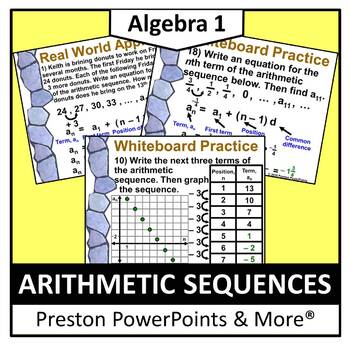(Alg 1) Arithmetic Sequences in a PowerPoint Presentation
- Zip
Description
Algebra 1 Arithmetic Sequences in a PowerPoint Presentation
This slideshow lesson is very animated with a flow-through technique. I developed the lesson for my Algebra 1 class, but it can also be used for upper level class reviews. This lesson teaches how to extend and graph arithmetic sequences, write equations for arithmetic sequences, and solve real-life situations by using arithmetic sequences to find how many donuts a coworker is bringing for Friday.
This lesson has SKELETON NOTES, notes that have the problem only. I used this with our 1-1 district devices. This will allow for the students to follow the lesson easier. There are 6 slides per page with plenty of room for notetaking. They are in a pdf format for easy printing too. A Word document is included for you to EDIT if you won’t be doing all of the problems so you can shorten it. I also made another version of skeleton notes that is only one or two sheets long in a pdf. When I printed off skeleton notes for the whole class this is what I used. It is also editable so you can delete the problems and rearrange the skeleton notes however you want.
NEW: The lesson is in an editable format so you can tailor the lesson to your class. The problems and clipart can’t be edited due to the TOU and to maintain the copyright integrity of the product. You can change the problem number and the names. Using student’s or teacher’s names can be another hook. If you need an alternative version because your country uses different measurements, units, or slight wording adjustment for language differences just email me at PrestonPowerPoints@gmail.com. I am respond to email quickly.
The presentation has 32 slides with LOTS of whiteboard practice. Use as many or as few of the problems to help your students learn each concept. For more PowerPoint lessons & materials visit Preston PowerPoints.
Students often get lost in multi-step math problems. This PowerPoint lesson is unique because it uses a flow-through technique, guided animation, that helps to eliminate confusion and guides the student through the problem. The lesson highlights each step of the problem as the teacher is discussing it, and then animates it to the next step within the lesson. Every step of every problem is shown, even the minor or seemingly insignificant steps. A helpful color-coding technique engages the students and guides them through the problem (Green is for the answer, red for wrong or canceled numbers, & blue, purple & sometimes orange for focusing the next step or separating things.) Twice as many examples are provided, compared to a standard textbook. All lessons have a real-world example to aid the students in visualizing a practical application of the concept.
This lesson applies to the Common Core Standard:
High School: Functions » Building Functions F.BF.2
Build a function that models a relationship between two quantities.
2. Write arithmetic and geometric sequences both recursively and with an explicit formula, use them to model situations, and translate between the two forms.
High School: Functions » Interpreting Functions F.IF.3
Understand the concept of a function and use function notation.
3. Recognize that sequences are functions, sometimes defined recursively, whose domain is a subset of the integers. For example, the Fibonacci sequence is defined recursively by f(0) = f(1) = 1, f(n+1) = f(n) + f(n-1) for n ≥ 1.
High School: Functions » Linear, Quadratic, & Exponential Models F.LE.2
Construct and compare linear, quadratic, and exponential models and solve problems.
2. Construct linear and exponential functions, including arithmetic and geometric sequences, given a graph, a description of a relationship, or two input-output pairs (include reading these from a table).
Are you looking for the Algebra 1 Linear Functions Bundle?Click here!
This resource is for one teacher only. You may not upload this resource to the internet in any form. Additional teachers must purchase their own license. If you are a coach, principal or district interested in purchasing several licenses, please contact me for a district-wide quote at prestonpowerpoints@gmail.com. This product may not be uploaded to the internet in any form, including classroom/personal websites or network drives.
*This lesson contains 22 problems. Each problem in this lesson uses several pages in order to achieve the animated flow-through technique.





